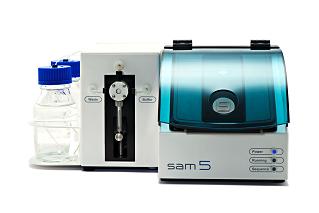Members Login

Channels
Special Offers & Promotions
Novel bioaffinity-MS tandem system developed
 Researchers at the University of Konstanz, have for the first time successfully developed a novel on-line bioaffinity-electrospray ionisation (ESI) mass spectrometry approach, which enables the simultaneous label-free detection, identification and quantification of protein-ligand interactions. Combining the sam5TM surface acoustic wave (SAW) biosensor from SAW Instruments directly with ESI-MS has enabled the direct connection of protein-ligand KD analysis with their subsequent quantification and structural characterisation by mass spec.
Researchers at the University of Konstanz, have for the first time successfully developed a novel on-line bioaffinity-electrospray ionisation (ESI) mass spectrometry approach, which enables the simultaneous label-free detection, identification and quantification of protein-ligand interactions. Combining the sam5TM surface acoustic wave (SAW) biosensor from SAW Instruments directly with ESI-MS has enabled the direct connection of protein-ligand KD analysis with their subsequent quantification and structural characterisation by mass spec.
This new tandem SAW-ESI-MS system has been developed in the laboratory of Professor Michael Przybylski at the University of Konstanz and recently published (Dragusanu et al, 2010)1. Biosensors have previously only ever been connected to mass spec indirectly in a MALDI-TOF format where crystallised sample spots are analysed. The new system is unique, as the first that directly connects liquid flow from the SAW biosensor directly into the ESI-MS via a standard desalting interface - an approach impossible with other available biosensors. This novel set-up enables direct quantitative determinations of protein-ligand complexes by SAW-yielded dissociation constants (KD) from low nanomolar to sub-micromolar sample concentrations.
The Przybylski team observed the key advantages of SAW in comparison to classical immuno-analytical bioaffinity techniques to be the direct and rapid determination of association/dissociation constants from small and dilute sample amounts, without the need for labelling or recalibration for buffer changes. Furthermore, the sam5 biosensor is able to make detection measurements in complex biological samples e.g. crude brain samples, blood or cell lysates.
The new SAW-ESI-MS technique has been successfully applied by the Przybylski group to a number of clinically relevant applications for biomarker discovery, analysis and epitope mapping. These include human β-amyloid peptides (Alzheimer's Disease), Substance P peptide-calmodulin complex, tyrosine-nitrated peptides (neurotoxic events) and human β-synuclein (Parkinson's Disease). Indeed, no details on affinity binding and KD determination of the anti-α-synuclein-human α-synuclein complex have previously been reported.
"We are confident that the new on-line SAW-ESI-MS approach utilising the sam5TM biosensor will develop into an efficient and sensitive tool for the label-free detection, identification and quantification of biopolymer-ligand interactions as diverse as antigen-antibody and lectin-carbohydrate complexes," said Professor Michael Przybylski. "Certainly SAW technology is now becoming increasingly popular for the study of biomacromolecular interactions due to its high detection sensitivity in dilute solutions and the results that we have obtained to date suggest a broad range of potential applications for this exciting new technique."
The sam5TM biosensor instrument from SAW Instruments is a unique tool for advanced real-time biomolecular interaction and kinetic studies. The sam5TM is a peerless biosensor utilising Surface Acoustic Wave (SAW) technology for the label-free detection of real-time binding and structural events. This new technology has been presented at a number of recent scientific events. Dr Thomas Gronewold from SAW Instruments will next present at this week's Affinity-Mass Spectrometry Workshop, 18-19th November 2010, University of Konstanz, Germany.
For more information, please see www.affinityms.de.
Media Partners


